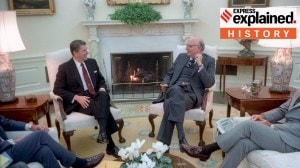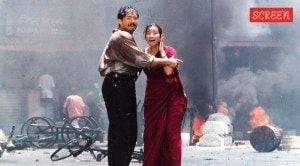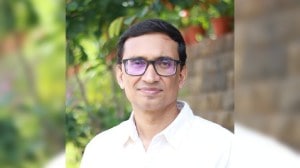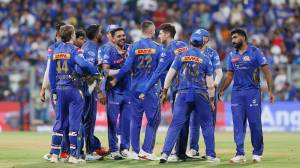UPSC Key: US-China tariff war, Extradition in International law and ANI vs Wikipedia
Why the Cabinet Committee on Security (CCS) is relevant to the UPSC exam? What is the significance of topics such as Tahawwur Rana, repo rate and Cervical cancer, on both the preliminary and main exams? You can learn more by reading the Indian Express UPSC Key for April 10, 2025.
 UPSC Key April 2025: Here's what you should be reading from the April 10, 2025 edition of The Indian Express
UPSC Key April 2025: Here's what you should be reading from the April 10, 2025 edition of The Indian Express Important topics and their relevance in UPSC CSE exam for April 10, 2025. If you missed the April 9, 2025 UPSC CSE exam key from the Indian Express, read it here
FRONT PAGE
Trump blinks with 90-day pause on tariffs but dials up China’s to 125%
Syllabus:
Preliminary Examination: Current events of national and international importance.
Mains Examination: General Studies II: Bilateral, regional and global groupings and agreements involving India and/or affecting India’s interests.
What’s the ongoing story: US President Donald Trump announced Wednesday that he is applying a 90-day pause on new tariffs as his trade war continues to ripple across the global economy.
At the same time, Trump revealed he is raising tariffs on Chinese goods to 125 per cent, ratcheting up his tit-for-tat with Beijing.
Key Points to Ponder:
• Why 90-day pause on new tariffs?
• US-China tariff war—what you know so far?
• ‘The recent tariff hikes by the US on China reflect a continuation of protectionist trade policies’—Explain
• Discuss the implications of such measures on the global trading system and India’s export sector.
• With the US announcing a 90-day pause on reciprocal tariffs, assess the effectiveness of trade pauses and negotiations in resolving trade disputes between major economies.
• “Tariff wars are a reflection of economic nationalism, but their consequences are global.”—Discuss
Key Takeaways:
• Beijing had earlier in the day raised the tariffs on a wide range of US goods to 84 per cent starting Thursday, a sharp escalation from the previously announced 34 per cent in retaliation to Trump’s ‘Liberation Day’ tariffs.
• Trump, in a Truth Social post, said he has “authorised a 90 day PAUSE, and a substantially lowered Reciprocal Tariff during this period, of 10%, also effective immediately.”
• The White House also confirmed Trump’s statement saying the lowered 10% tariff for other countries are effective immediately. President Trump in his post also stated that he was increasing US tariffs on China to pressure Beijing into negotiations.
• Moments after the announcement, Treasury Secretary Scott Bessent called it rewarding for the countries that chose not to retaliate amid a brewing trade war. “Do not retaliate, and you will be rewarded,” he said. He noted that the tariff rate on Chinese goods has been raised “due to their insistence on escalation”. “It took great courage, great courage for him to stay the course until this moment,” Bessent told reporters at the White House, CNN reported. “Every country in the world who wants to come and negotiate, we are willing to hear you,” he added.
• The White House’s press secretary, Karoline Leavitt, said Trump had raised tariffs against China because “when you punch at the United States of America, President Trump is going to punch back harder”.
• Global markets surged after Trump announcement with S&P 500 surging 5.6%, while the Nasdaq jumping over 8%.
• China has pledged “resolute and forceful” countermeasures after sweeping — part of a wider package targeting 60 countries — officially came into effect just after midnight Wednesday US time.
Do You Know:
• The looming slugfest between the world’s two largest economies is casting a dark shadow over global trade, with analysts raising the spectre of an American recession.
• China and the United States edged dangerously close to a full-blown trade war on Tuesday after President Donald Trump announced a staggering 104 per cent tariff on all Chinese imports. Locked in an escalating showdown, neither side showed signs of backing down — with Beijing vowing to resist US pressure “to the end.”
• Trump initially imposed a 34 per cent tariff on Chinese goods, which was swiftly met with an equivalent retaliatory measure by Beijing. In response, the US added another 50 per cent in duties. When combined with earlier levies from February and March, the total tariff burden on Chinese imports under Trump’s second term now stands at 104%, bringing fears of a near-embargo scenario.
• In February, Donald Trump slapped a 10 per cent tariff on all Chinese goods with no carve-outs, citing Beijing’s alleged role in fuelling illegal immigration and facilitating the flow of fentanyl into the United States. Last month, he doubled those rates — a move that sent shockwaves through global markets and deepened already strained US-China relations.
• China, which was America’s second-largest source of imports last year, shipped $439 billion worth of goods to the US, compared to $144 billion in American exports to China. The rising tariffs now threaten to hit domestic industries hard, with businesses warning of cost surges, layoffs, and reduced competitiveness.
• By the end of Trump’s first term, the average US tariff on Chinese goods stood at 19.3 per cent, according to the Peterson Institute for International Economics. The Biden administration largely maintained those tariffs — even expanding them — bringing the average to 20.8 per cent.
Other Important Articles Covering the same topic:
Tahawwur Rana, extradited from US for his role in 26/11, reaches Delhi today
Syllabus:
Preliminary Examination: Current events of national and international importance.
Mains Examination: General Studies II: Bilateral, regional and global groupings and agreements involving India and/or affecting India’s interests.
What’s the ongoing story: Indian security agencies braced for the arrival Thursday of Tahawwur Rana, being extradited from the US nearly 16 years after his arrest for his role in the 26/11 Mumbai terror attacks.
Key Points to Ponder:
• What is the meaning of extradition in international law?
• What is the extradition act of India?
• Extradition Treaty Between the United States of America and India—Know in brief
• Who is Tahawwur Rana?
• ‘Extradition is a critical component of international cooperation in counter-terrorism’—Comment
• What challenges India faced in securing extradition of Tahawwur Rana from US?
Key Takeaways:
• On Wednesday evening, the Nayayik Abhiraksha Vahini of Delhi Police was asked by the National Investigation Agency (NIA) to send a jail van, along with pilot escorts, to the airport around 7 am Thursday, ahead of Rana’s arrival.
• The Delhi Police Special Cell has been placed on alert and SWAT commandos have already been deployed at the airport.
• A team of three senior officers of the NIA, along with three intelligence officials, reached the US Sunday to obtain custody of Rana, sources in the Ministry of Home Affairs said.
• The source said the team obtained Rana’s custody and he would be reaching Delhi Thursday. It is likely that he will be placed under judicial custody in Tihar Jail.
• Also Wednesday, Union Home Minister Amit Shah held a meeting with External Affairs Minister S Jaishankar and National Security Advisor Ajit Doval to discuss the preparations.
• According to sources, once Rana reaches Delhi, he is likely to be sent to judicial custody — he will be produced before a court via a video link.
Do You Know:
• Even as the alleged plotter of the 26/11 terror attack, Tahawwur Rana, is being extradited to India from the United States, it was the National Investigation Agency (NIA) that went to the US to get his custody as against the Mumbai Police that had investigated the terror attacks case and filed the first chargesheet.
• One of the reasons why the NIA will get first custody is the fact that the Mumbai Police in its original chargesheet filed in 2009 had not named Rana as a wanted accused, while the NIA had filed a chargesheet against him and other wanted accused in 2011 in the case filed in Delhi by the central agency in 2009.
• The NIA filed the chargesheet before a Delhi court against nine persons, including seven Pakistani nationals and main conspirators, under sections including murder, criminal conspiracy, waging a war against the nation, of the Indian Penal Code and sections of the Unlawful Activities (Prevention) Act. The agency had detailed their roles in planning terror conspiracies, including the 26/11 attacks. It was also on its request that the Red Corner Notice was issued against Rana and others, necessary for extradition requests.
• In Mumbai, it was only in 2023 when talks of his extradition gathered momentum and papers were sought that realisation dawned that he had not been named as a wanted accused. Following this, the crime branch filed a chargesheet in the matter detailing Rana’s role.
• In Mumbai, the trial in the 26/11 case is pending against Abu Jundal. It has been stayed by the Bombay High Court currently. In the first phase of the case, the trial of Ajmal Kasab, who was arrested on November 26, 2008, took place in a Mumbai court, which convicted him, and it was confirmed by the Bombay High Court and then the Supreme Court, leading to his execution in 2012.
Other Important Articles Covering the same topic:
📍Why NIA, and not Mumbai Police, got first access to Rana
RBI cuts key rate by 25 basis points, growth projection lowered to 6.5%
Syllabus:
Preliminary Examination: Economic and Social Development-Sustainable Development, Poverty, Inclusion, Demographics, Social Sector Initiatives, etc.
Mains Examination: General Studies III: Indian Economy and issues relating to planning, mobilization, of resources, growth, development and employment
What’s the ongoing story: The Reserve Bank of India’s Monetary Policy Committee (MPC) reduced the repo rate by 25 basis points (bps) to 6 per cent Wednesday while the growth forecast for the current fiscal (FY2026) was lowered to 6.5 per cent from 6.7 per cent amid uncertainties arising from trade wars following the reciprocal tariffs announced by the US.
Key Points to Ponder:
• Why Reserve Bank of India reduced the repo rate by 25 basis points (bps)?
• What will happen to lending, deposit rates?
• What happens when RBI decreases repo rate?
• What is repo rate?
• What is the Current Repo Rate?
• What is Cash Reserve Ratio (CRR) Rate?
• How this move will impact overall Economy?
• What does accommodative stance mean with respect to monetary policy?
• What is Monetary Policy Framework?
• What are the steps taken by RBI to control inflation?
• What is Monetary policy?
• What is the primary objective of the monetary policy?
• There are two aspects to any monetary policy-What are they?
• The Monetary Policy Committee (MPC) is a Statutory Body-True or False?
• What is the composition of Monetary Policy Committee (MPC)?
• Know the Types of Inflation like Moderate Inflation, Galloping Inflation, Hyper-Inflation, Stagflation, Deflation, Core Inflation, Headline Inflation etc.
• What are the causes of Inflation in the present situation
• How Inflation is Measured in India?
• Impact of increase in the REPO and CRR on Money Supply on an Economy-Inflation or Deflation?
• Know about these terms-Bank Rate, Reverse Repo Rate, Liquidity Adjustment Facility (LAF), Marginal Standing Facility (MSF), Marginal cost of funds based lending rate (MCLR) etc.
Key Takeaways:
• Announcing the monetary policy, RBI Governor Sanjay Malhotra said the trade tariff related measures have exacerbated uncertainties clouding the economic outlook across regions, posing new headwinds for global growth and inflation.
• He warned that tariffs will impede domestic growth and may have a negative impact on net exports. Malhotra, however, said the impact on domestic inflation is unlikely to be very concerning due to easing of commodity and crude oil prices.

• The six-member rate-setting panel changed the monetary policy stance from ‘neutral’ to ‘accommodative’, signalling more cuts in the offing.
• The cut in repo rate will provide relief to borrowers of various loans, including home and personal, as their equated monthly instalments (EMIs) will decline by 25 bps. The cut will also lead to a reduction in bank deposit rates.
• This is the second consecutive policy when the MPC has slashed the repo rate — the rate at which the RBI lends money to banks to meet their short-term funding needs — by 25 bps. In the February policy, the MPC, for the first time in nearly five years, reduced the repo rate to 6.25 from 6.5 per cent.
• The RBI also revised the consumer price inflation (CPI) forecast for the financial year 2025-26 to 4 per cent, as against an earlier expectation of 4.2 per cent.
Do You Know:
• People go to commercial banks either to deposit their savings or to get a loan. On savings/deposits, the bank pays interest to the depositor while on loans, it charges interest to the borrower. Typically, the interest rate banks charge on loans is higher than the interest they pay on deposits. This is how they make money.
• A key deciding factor — although not the only one — is the interest rates that commercial banks themselves pay (or get) when they borrow (or deposit) money from (or in) the RBI. The interest rate that the RBI charges when commercial banks borrow money from it is called the repo rate. The interest rate the central bank pays commercial banks when they park their excess cash is called the reverse repo rate.
• Using these two rates, the RBI sets the tone for all other interest rates in the banking system, and through that route, in the broader economy.
• For instance, when the RBI wants to encourage economic activity in the economy, it reduces the repo rates. Doing this enables commercial banks to bring down the interest rates they charge (on their loans) as well as the interest rate they pay on deposits. This, in turn, incentivises people to spend money, because keeping their savings in the bank now pays back a little less, and businesses are incentivised to take new loans for new investments because new loans now cost a little less as well.
• On the other hand, when the RBI wants to control inflation, it increases the repo rate. Banks thus have to pay more interest to borrow from the RBI, which means they will charge more interest to their borrowers. At a macro level, this inhibits people from borrowing money as well as from spending, which in turn reduces the amount of money in the market, and thus negates inflation.
• The central bank’s decision comes amidst heightened global economic uncertainty in the face of the far reaching reciprocal tariffs announced by the Donald Trump administration in the US.
Other Important Articles Covering the same topic:
UPSC Previous Year Prelims Question Covering similar theme:
1. Consider the following statements: (2020)
1. The weightage of food in Consumer Price Index (CPI) is higher than that in Wholesale Price Index (WPI).
2. The WPI does not capture changes in the prices of services, which CPI does.
3. The Reserve Bank of India has now adopted WPI as its key measure of inflation and to decide on changing the key policy rates.
Which of the statements given above is/are correct?
(a) 1 and 2 only
(b) 2 only
(c) 3 only
(d) 1, 2 and 3
AIIMS researchers develop blood test to monitor cervical cancer treatment
Syllabus:
Preliminary Examination: Current events of national and international importance.
Mains Examination: General Studies II: Issues relating to development and management of Social Sector/Services relating to Health, Education, Human Resources.
What’s the ongoing story: A simple blood test may help determine whether your cervical cancer is responding to treatment or whether it has relapsed, shows early research by doctors from the All India Institute of Medical Sciences, Delhi.
Key Points to Ponder:
• Know about Cervical cancer
• What is the main cause of cervical cancer?
• How common is cervical cancer in India?
• What exactly early research by doctors from the All India Institute of Medical Sciences, Delhi says?
• Why is this study significant?
• What the study found?
Key Takeaways:
• They found fragments of the DNA of human papillomavirus (HPV) — the virus responsible for the vast majority of cervical cancer cases — circulating in the blood, with their levels correlating with the size of the tumour. As patients began treatment, these levels dropped, indicating how the cancer cells were responding to treatment.
• The findings have been published in the Nature group journal, Scientific Reports.
• This could be a game-changer as cervical cancer is the second most common cancer among women in India with more than 95 per cent cases linked to persistent infection with certain high-risk strains of HPV. As normal screening and follow-ups are cumbersome and costly, a blood test could be a cheaper alternative.
• Doctors used a very sensitive molecular test to detect trace amounts of DNA of the two most common high-risk HPV strains — HPV16 and HPV18. They selected 60 cervical cancer patients who had not started their treatment. They also collected samples from 10 healthy women to compare the results with.
Do You Know:
• The average level of circulating viral DNA in the cancer patients was 9.35 ng/µL (a measure of concentration) while it was 6.95 ng/µL among healthy women. The doctors were also able to show that after three months of treatment, the level of circulating DNA reduced to 7 ng/µL.
• Once proven in a larger cohort, the test may be used for initial diagnosis as well as early detection because 90% of patients who reached the hospital were already in the second or third stages of the disease. The likelihood of survival reduces with cancers detected in later stages.
• As of now, the most common test for cervical cancer screening is pap smear, where the cells collected from the surface of the cervix on a swab are studied under the microscope to detect changes. The other commonly used test, especially in resource-scarce areas, is visual inspection with acetic acid. A solution with 3-5% concentration of acetic acid is applied on the cervix, which reacts with pre-cancerous or cancerous cells to give a whitened appearance.
• For the final diagnosis and staging of the cancer, patients have to undergo a biopsy. This is also where the blood test may come in handy.
• There were 1.27 lakh cervical cancer cases and 79,979 deaths in 2022 in India, according to data from the World Health Organisation’s Global Cancer Observatory. The overall survival rate of cervical cancer in India is around 46 per cent, according to the study.
• The good thing is cervical cancer is one of the only vaccine-preventable cancers. The government is considering cervical cancer vaccination in girls between the ages of nine and 14.
Other Important Articles Covering the same topic:
📍Govt set to roll out vaccine drive to fight cervical cancer
UPSC Previous Year Mains Question Covering similar theme:
📍What are the research and developmental achievements in applied biotechnology? How will these achievements help to uplift the poorer sections of the society ? (2021)
GOVT & POLITICS
CCS approves `64,000-crore deal to procure 26 Rafale-M jets for Navy
Syllabus:
Preliminary Examination: Current events of national and international importance.
Mains Examination: General Studies II: Government policies and interventions for development in various sectors and issues arising out of their design and implementation.
What’s the ongoing story: The Cabinet Committee on Security (CCS), chaired by Prime Minister Narendra Modi, on Wednesday cleared a proposal to procure 26 naval variants of Rafale fighter jets from France at a cost of around `64,000 crore for deployment on board aircraft carrier INS Vikrant, sources in the defence establishment said.
Key Points to Ponder:
• What is Cabinet Committee on Security (CCS)?
• Who chairs Cabinet Committee on Security (CCS)?
• What are the various Cabinet committees?
• Why is CCS so important?
• How this move enhances India’s naval air power and deterrence in the Indo-Pacific region?
• Discuss the role of the Cabinet Committee on Security (CCS) in India’s national security and defence acquisition process.
• Evaluate the evolving role of the Indian Navy in safeguarding national interests, especially in the context of aircraft carrier-based operations.
Key Takeaways:
• The delivery of the jets will begin around five years after the signing of the contract under an inter-governmental framework between India and France.
• In July 2023, the defence ministry accorded the initial approval for the mega acquisition following a series of deliberations and evaluation tests of the platform.
• Under the deal, the Indian Navy will also get associated ancillary equipment including weapon systems and spares from Dassault Aviation, the manufacturer of Rafale (Marine) jets.
• The Indian Air Force bought 36 Rafale fighter aircraft in fly-away condition. There is a thinking in the IAF that it should go for at least two more squadrons of Rafale jets.
• The defence and strategic ties between India and France have been on an upswing in the last few years.
• In July 2023, India and France announced a raft of ground-breaking defence cooperation projects including the joint development of jet and helicopter engines. The two strategic partners also had expressed commitment to cooperate in the co-development and co-production of advanced defence technologies, including for the benefit of third countries.
• The Defence Ministry also approved a proposal nearly two years back to procure three Scorpene submarines to further crank up India’s naval prowess.
• However, the CCS is yet to approve it. Under Navy’s Project 75, six Scorpene submarines have already been constructed in India by Mazagon Dock Ltd in cooperation with Naval Group of France.
Do You Know:
• Once the Union Cabinet is sworn in and ministerial portfolios are allocated, the next step would be the formation of the high-profile Cabinet committees. The Prime Minister sets up these committees with selected members of the Cabinet and assigns specific functions to these committees. The Prime Minister may change the numbers of committees, and modify the functions assigned to them.
• The membership of each committee varies from three to eight. Usually, only Cabinet ministers are members of these committees. However, it is not unheard of for non-Cabinet ministers to be members or special invitees to committees. If the Prime Minister himself is a member of any such committee, he acts as the head of that committee.
• The committees resolve issues and formulate proposals for the consideration of the Cabinet and take decisions on matters assigned to them. The Cabinet is empowered to review such decisions.
• There are eight Cabinet committees at present — the Appointments Committee of the Cabinet, Cabinet Committee on Economic Affairs, Cabinet Committee on Political Affairs, Cabinet Committee on Investment and Growth, Cabinet Committee on Security, Cabinet Committee on Parliamentary Affairs, Cabinet Committee on Employment & Skill Development, and Cabinet Committee on Accommodation.
• The committees on investment and employment were innovations introduced by the Modi government in 2019. All committees except the Cabinet Committee on Accommodation and Cabinet Committee on Parliamentary Affairs are headed by the PM.
Other Important Articles Covering the same topic:
📍Knowledge nugget of the day: Cabinet Committee on Security
UPSC Previous Year Prelims Question Covering similar theme:
2. Consider the following statements: (UPSC CSE, 2022)
1. The Constitution of India classifies the ministers into four ranks viz. Cabinet Minister, Minister of State with Independent Charge, Minister of State and Deputy Minister.
2. The total number of ministers in the Union Government, including the Prime Minister, shall not exceed 15 percent of the total number of members in the Lok Sabha.
Which of the statements given above is/are correct?
(a) 1 only
(b) 2 only
(c) Both 1 and 2
(d) Neither 1 nor 2
Can’t order takedown only because we don’t like content: Top court in ‘ANI vs Wikimedia’
Syllabus:
Preliminary Examination: Current events of national and international importance.
Mains Examination: General Studies II: Structure, organization and functioning of the Executive and the Judiciary
What’s the ongoing story: The Supreme Court Wednesday reserved its verdict on Wikimedia Foundation’s appeal against the Delhi High Court order to take down a page titled ‘Asian News International v. Wikimedia Foundation’, while observing that courts cannot order content takedowns just because they don’t like the material.
Key Points to Ponder:
• ANI vs Wikipedia: What’s the case?
• What has happened so far?
• What happened in the last hearing?
• What are the implications of legal interventions in such platforms on information access and editorial autonomy?
• Discuss the legal and ethical challenges involved in content takedown orders in the digital era.
Key Takeaways:
• The Wikipedia page carried details of the High Court hearing on a defamation complaint filed by ANI against Wikipedia, including the comments of the judge.
• Justice A S Oka, presiding over a two-judge bench, said that the High Court has the power to direct content takedowns only if there is a prima facie finding that the material in question is contemptuous.
• Senior Advocate Kapil Sibal, appearing for Wikimedia Foundation, pointed out the allegedly objectionable part to the bench.
• The court said that an expression in the page, “threatened”, referring to the observations made by the judge during the hearing, should not have been used.
• Referring to an article on the page about the observations made during the hearing before the HC, Sibal said it was authored by a visiting professor at Harvard, appeared in The Indian Express and was mentioned in a footnote.
• The counsel for ANI said the principal question is about the manner of functioning of Wikipedia.
Sibal contended: “You can’t say there should be no discussion. We have an open justice system; this has a chilling effect.”
Do You Know:
• ANI has argued that Wikipedia is a significant social media intermediary under the meaning of Section 2(1)(w) of the Information Technology Act, 2000: “any person who on behalf of another person receives, stores or transmits that record or provides any service with respect to that record and includes telecom service providers, network service providers, Internet service providers, web-hosting service providers, search engines, online payment sites, online-auction sites, online-market places and cyber cafes”.
• The petitioner has also relied on Sections 79(2) and (3) of the Act, which lay down the requirements for the “safe harbour clause” to come into effect.
• Section 79 of the IT Act (Exemption from liability of intermediary in certain cases) states that an intermediary shall not be held legally or otherwise liable for any third-party information, data, or communication link made available or hosted on its platform.
• This protection shall be applicable if the intermediary does not in any way initiate the transmission of the message in question, select the receiver of the transmitted message, or modify any information contained in the transmission, according to Section 79(2)(b).
• Another requirement for safe harbour protection is that the intermediary must adhere to the Intermediary Guidelines and Digital Media Ethics Code, which came into force in 2021. The guidelines mandated setting up a grievance-redressal mechanism, along with a resident grievance officer, a chief compliance officer, and a nodal contact person.
• Section 79(3) states that the protection will not apply if the intermediary, despite being informed by the government or its agencies, does not immediately remove or disable access to the material in question.
• Additionally, the intermediary cannot tamper with any evidence of these messages or content on its platform, failing which it would lose its protection under the Act.
Rule 7 of the IT Rules, 2021 states that if “an intermediary fails to observe these rules, the provisions sub-section (1) of section 79 of the Act shall not be applicable”, and “the intermediary shall be liable for punishment under any law for the time being in force”.
• Section 230 of the US Communications Decency Act is analogous to Section 79 of the IT Act. It states that “no provider or user of an interactive computer service shall be treated as the publisher or speaker of any information provided by another information content provider”.
Other Important Articles Covering the same topic:
📍Why has ANI slapped a defamation case against Wikipedia?
THE IDEAS PAGE
Syllabus:
Preliminary Examination: Indian Polity and Governance-Constitution, Political System, Panchayati Raj, Public Policy, Rights Issues, etc.
Mains Examination: General Studies II: Appointment to various Constitutional posts, powers, functions and responsibilities of various Constitutional Bodies.
What’s the ongoing story: Faizan Mustafa Writes: Governors behave in this manner because they have no security of tenure. Let us give them some security of tenure like judges, and they would act more independently.
Key Points to Ponder:
• What exactly Supreme Court said about the Tamil Nadu Governor R N Ravi?
• What Tamil Nadu Governor did with the bills?
• Why the Supreme Court set aside Tamil Nadu Governor R N Ravi’s decision to withhold assent to 10 pending Bills?
• What are the important constitutional provisions related to the Governor?
• What does the Constitution say about the Governor’s role in giving assent to Bills passed by the state legislature?
• What had the Supreme Court said on this issue earlier?
• The office of the Governor has often been seen as an agent of the Centre rather than a constitutional head of the State’—How far you agree with the same?
Key Takeaways:
Faizan Mustafa Writes:
• “The good governors should have a broken leg and keep at home,” said Miguel de Cervantes. These were the ideals under which the governor was envisioned as having a faint presence, like a full moon on a mid-day. His primary role as a sagacious counsellor was “to be consulted, to warn and to encourage”. He has to be above politics. But India’s experience with governors has been quite disappointing.
• It seems that governors appointed by the current government have gone far beyond their Congress-nominated counterparts in making elected state governments non-functional. Not only has there been an unfortunate tug of war on the appointment of vice-chancellors, nominations to the state legislative councils and the editing of the customary address by the governor or summoning of the House but also the delay/denial of assent to bills passed by legislative assemblies.
• The relationship between governors and opposition chief ministers has never been so strained, except for a few exceptions when the chief ministers were dismissed, and President’s Rule was imposed during the tenure of erstwhile Congress governments.
• Justice J B Pardiwala and R Mahadevan’s historic judgment on April 8 is the bold answer to remedy this decline.
• Elected representatives should indeed have more powers than nominated governors. States should be free to legislate on the 66 subjects that are under their exclusive jurisdiction as per the Seventh Schedule. The Supreme Court, invoking its extraordinary powers under Article 142, has laid down strict timelines for assent to bills by governors.
• The Court has scrapped the myth that governors under Article 200 have been given absolute discretion with respect to assenting bills passed by the elected representatives.
• Justice Pardiwala, by laying down time limits for assent, reconsideration or reserving the bill for presidential assent, saved federal democracy from the clutches of unelected governors who, under Article 159, are obliged to preserve, protect and defend the Constitution.
Do You Know:
Faizan Mustafa Writes:
• The Tamil Nadu governor’s decision to withold assent for months and then referring as many as 10 bills passed by the assembly for reconsideration for the President has rightly been found arbitrary and thus unconstitutional.
• In an unprecedented finding, the Court has deemed all bills from the date submitted to the governor as assented. It even found the governor’s actions were not bona fide because he only acted after the Supreme Court’s observation against the governor withholding assent in a 2023 case from Punjab. Even the presidential action on them has been deemed non est in law.
• Despite our opposition to the office of governor during colonial rule, it was retained to preserve the unity, stability and security of the country. Jawaharlal Nehru favoured the appointment of eminent academicians from outside politics and other outstanding and impartial people from other walks of life as governors.
• Initially, B N Rau, then the constitutional advisor to the constituent assembly, had proposed that the governor be elected by the provincial legislature by secret vote. Sardar Patel, who headed the Provincial Constitution Committee too had recommended that the governor should be elected by the people of the state for a term of four years and could be impeached for “misbehaviour”. Jayaprakash Narayan wanted the governor’s appointment to be made by the President out of a panel of four persons selected by the Assembly and Members of Parliament of the concerned state.
• The central government would always consult chief ministers in appointing governors. T T Krishnamachari said that the chief minister would have veto power in this regard. Even the Sarkaria Commission (1983) recommended the same thing and said the Vice-President and Speaker of Lok Sabha should also be consulted.
• The SC in Raghukul Tilek (1979) held that governors are not employees of the Centre but hold high constitutional office. But governors behave in this partisan manner because they have no security of tenure. They have less protection than a junior civil servant. Let us give them some security of tenure like judges, and they would act more independently.
Other Important Articles Covering the same topic:
📍Among 10 Bills over which TN Governor faces SC ire: Those on varsities, 2 of ex-govt
UPSC Previous Year Prelims Question Covering similar theme:
3. Which one of the following suggested that the Governor should be an eminent person from outside the State and should be a detached figure without intense political links or should not have taken part in politics in the recent past? (2019)
(a) First Administrative Reforms Commission (1966)
(b) Rajamannar Committee (1969)
(c) Sarkaria Commission (1983)
(d) National Commission to Review the Working of the Constitution (2000)
2. Which of the following are the discretionary powers given to the Governor of a State? (2014)
1. Sending a report to the President of India for imposing the President’s rule
2. Appointing the Ministers
3. Reserving certain bills passed by the State Legislature for consideration of the President of India
4. Making the rules to conduct the business of the State Government
Select the correct answer using the code given below
a) 1 and 2 only
b) 1 and 3 only
c) 2, 3 and 4 only
d) 1, 2, 3 and 4
| PRELIMS ANSWER KEY |
| 1. (a) 2.(b) 3.(c) 4.(b) |
For any queries and feedback, contact priya.shukla@indianexpress.com
Subscribe to our UPSC newsletter. Stay updated with the latest UPSC articles by joining our Telegram channel – IndianExpress UPSC Hub, and follow us on Instagram and X.
Must Read
Buzzing Now



Apr 18: Latest News
- 01
- 02
- 03
- 04
- 05
























